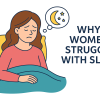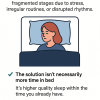How to Fall Asleep Fast🌙💤
How CBT-I Can Transform Your Sleep Experience
We've all been there (me too) —lying in bed, watching the minutes tick by as sleep remains frustratingly out of reach. For those with insomnia, this isn't just an occasional annoyance; it's a nightly battle that can leave you exhausted, frustrated, and anxious about bedtime. If you're tired of staring at the ceiling, Cognitive Behavioral Therapy for Insomnia (CBT-I) might be the solution you haven't fully explored yet.
Why Taking Forever to Fall Asleep Isn’t Just "Normal"
Many people who struggle with sleep have come to accept that taking 30, 60, or even 90 minutes to fall asleep is just "how they're wired." But sleep experts disagree. In healthy sleepers, sleep onset typically takes between 10-20 minutes—long enough to transition naturally from wakefulness to sleep, but not so long that you're left alone with your thoughts for hours.
"The misconception that some people are just 'built' to take a long time to fall asleep can prevent them from seeking help," explains Dr. Rachel Manber, a leading CBT-I researcher at Stanford University.
How CBT-I Specifically Targets Sleep Onset Problems
CBT-I is a structured program that addresses the underlying causes of insomnia rather than just masking the symptoms. For those who struggle specifically with falling asleep, several CBT-I components can be particularly transformative:
1. Rebuilding Your Sleep Drive
One of the most effective—though initially challenging—aspects of CBT-I is sleep restriction therapy. This involves temporarily reducing your time in bed to match your actual sleep time.
"Sleep restriction works because it builds up your natural sleep drive," explains sleep therapist Dr. Colleen Carney. By limiting your time in bed, you'll initially feel more tired—but that's actually the goal. As your sleep becomes more efficient, your sleep window gradually expands.
2. Breaking the Bed-Wakefulness Association
If you've spent countless hours awake in bed, your brain may have formed an unhelpful association between your bed and wakefulness. CBT-I's stimulus control techniques work to break this connection:
Only go to bed when you're truly sleepy (not just tired).
If you don't fall asleep within about 20 minutes, get out of bed and do something relaxing in dim light.
Return to bed only when you feel sleepy again.
Use your bed only for sleep and intimacy—not for watching TV, working, or scrolling on your phone.
"By getting out of bed when you're not sleeping, you're strengthening the connection between your bed and actual sleep," says Dr. Michael Perlis, Director of the Behavioral Sleep Medicine Program at the University of Pennsylvania.
3. Quieting the Pre-Sleep Mental Chatter
For many insomnia sufferers, bedtime brings a flood of thoughts—from tomorrow's to-do list to worries about not sleeping. CBT-I offers several strategies to address this mental hyperactivity:
Scheduled worry time: Set aside 15-20 minutes in the early evening to write down worries and possible solutions.
Cognitive restructuring: Learn to identify and challenge unhelpful thoughts about sleep.
Mindfulness techniques: Practice observing thoughts without engaging with them, allowing them to pass.
"Many people try to force sleep by trying harder, which activates the fight-or-flight system—exactly the opposite of what you need for sleep," explains Dr. Jason Ellis, Professor of Sleep Science.
Real Results: How Quickly Can You See Changes?
While individual results vary, many people begin seeing improvements in their sleep-onset time within the first two weeks of consistent CBT-I practice. A study published in the Journal of Clinical Sleep Medicine found that participants' time to fall asleep decreased by an average of 19 minutes after just two weeks of treatment.
Getting Started With CBT-I
If waiting ages to fall asleep has become your unwelcome nightly routine, here are ways to access CBT-I:
Work with a specialist: A CBT-I trained therapist can provide personalized guidance.
Digital CBT-I programs: Apps and online programs offer structured treatment at home.
Self-help books: Many excellent CBT-I workbooks provide step-by-step guidance.
Beyond the Basics: Fine-Tuning Your Pre-Sleep Routine
While working through a formal CBT-I program, these additional strategies can support faster sleep onset:
Develop a wind-down routine: Create a consistent 30-60 minute pre-sleep ritual.
Temperature management: Slightly cooler bedroom temperatures (around 65°F/18°C) can help facilitate sleep onset.
Light exposure management: Get bright light exposure in the morning and limit blue light exposure in the evening.
Relaxation techniques: Progressive muscle relaxation, 4 7 8 breathing, or body scanning can help ease physical tension.
When Falling Asleep Quickly Becomes Your New Normal
The most beautiful aspect of CBT-I is that, unlike sleep medication, the benefits tend to last long after treatment ends. By addressing the root causes of your sleep difficulties, you're building skills and habits that create lasting change.
"Many of my patients express surprise when falling asleep becomes something that 'just happens' rather than something they struggle to achieve," says Dr. Carney.
If you've been living with the frustration of long sleep onset times, know that it doesn't have to be your permanent reality. With the evidence-based strategies of CBT-I, falling asleep can transform from a nightly battle into a natural transition—allowing you to reclaim those precious hours of restfulness and wake feeling genuinely refreshed.
Sleep well. 🌙💤







